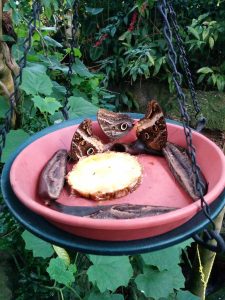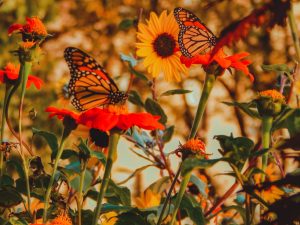Are you interested in attracting more beautiful butterflies to your yard? Creating a DIY butterfly feeder is a fun and easy project that can help attract more of these essential pollinators to your garden. In this post, we’ll go over everything you need to know to make your own homemade butterfly feeder and attract more butterflies to your yard.
But first, why are butterflies so important? Butterflies, along with other pollinators such as bees and hummingbirds, play an essential role in pollinating flowers and crops. Without pollinators, many plants would not be able to reproduce, which would have a devastating effect on our food supply and the natural world around us. By creating a butterfly feeder, you can help support these important pollinators and enjoy the beauty of these winged creatures.
How to Make a Butterfly Feeder
Making DIY butterfly feeders is surprisingly easy and can be done in just a few simple steps.

Materials Needed:
- A plastic plate or pie tin
- Acrylic plate or two pieces of clear plastic
- Twine or string
- A tree branch or other sturdy item to hang the feeder from
- Beads (optional)
- A sponge or cotton ball
- Granulated sugar
- Water
- Fruit or fruit juice (optional)
Steps to Create a Butterfly Feeder
- Start by creating a small hole in the center of your plastic plate or pie tin. This will be used to hang the feeder later.
- If you’re using an acrylic plate, you can skip this step. Otherwise, cut two pieces of clear plastic to fit the size of your plate or tin. Use a small hole punch to create a hole in the center of each piece of plastic.
- Thread a piece of twine through the hole in the plate or tin and tie a knot to secure it. Then thread the twine through the holes in the clear plastic pieces and tie another knot to secure them in place.
- Choose a tree branch or other sturdy item to hang your feeder from. Make sure it is in a cool, shaded area, as butterflies prefer cooler temperatures.
- Mix together a sugar solution to create the butterfly nectar. Mix one part granulated sugar with four parts water until the sugar dissolves. You can also add a small piece of overripe fruit or some fruit juice to the mixture for added flavor.
- Soak a sponge or cotton ball in the sugar solution and place it on the plate or pie tin. Alternatively, you can fill the plate or tin with the sugar solution directly.
- If you want to add some visual interest to your feeder, you can thread some beads onto the twine above the plate or tin.
- Hang your butterfly feeder in your yard, making sure to fill it with fresh nectar every few days.
Placement of the Butterfly Feeder
When choosing a spot to hang your butterfly feeder, make sure to choose a spot that is visible to butterflies. Hang the feeder near flowers or other plants that butterflies like to feed on, and make sure it is in a cool, shaded area.
Maintenance of the Butterfly Feeders

It’s important to keep your butterfly feeder clean and well-maintained to ensure it attracts the most butterflies possible. Make sure to clean the feeder regularly with soap and water to prevent mold and bacteria buildup. You should also refill the feeder with fresh nectar every few days, especially during the warmer months when butterflies are most active.
Attracting Butterflies to the Feeder
To attract even more butterflies to your feeder, make sure you have the right plants in your yard. Butterflies are attracted to bright colors, especially purple, pink, and yellow. Plant flowers that bloom in the spring and summer to ensure a steady supply of nectar for the butterflies. You can also plant milkweed, which is a host plant for many butterfly species.
Even with a simple butterfly feeder, you can help support these important pollinators and enjoy their beauty all season long.
Butterfly Food Sources
In addition to flowers, butterflies can also feed on fruit and tree sap. If you have a fruit tree in your yard, make sure to leave some overripe fruit on the ground for the butterflies to enjoy. You should also try leaving out pieces of banana or oranges near the butterfly feeder to attract more of these beautiful creatures.
Butterfly food mixture can also be purchased online or at local garden stores. These mixtures usually contain a variety of essential vitamins and minerals that butterflies need to stay healthy. They are also a great way to supplement your butterfly feeder and make sure the butterflies have plenty of food options in your yard.
Butterfly Garden Design

A butterfly garden can help attract even more of these beautiful creatures to your yard. The design should include different types of flowers, such as coreopsis, daisies, and asters, that will bloom throughout the year. You should also include host plants like milkweed and lantana for butterflies to lay eggs on. Planting a variety of flowers and plants will ensure there is always something blooming for the butterflies to feed on.
Finally, make sure your butterfly garden has plenty of places for butterflies to rest. Adding rocks or logs that are in the sun but away from direct wind can provide a safe place for them to perch. You should also add some shallow mud puddles, as butterflies will drink from these areas.
Creating a butterfly garden and adding a butterfly feeder to your yard is a great way to attract these beautiful creatures. With the right maintenance and food sources, you can create a haven for butterflies in your own backyard.
Final Thoughts: Create Your Own Butterfly Feeder
Creating a DIY butterfly feeder is a fun and easy project that can help attract more butterflies to your yard. By providing a source of nectar, you can support these essential pollinators and enjoy their beauty in your backyard. With just a few simple materials and some basic steps, you can create a homemade butterfly feeder that will attract a variety of butterfly species.
Remember to choose a spot that is visible to butterflies and near plants that they like to feed on. Keep your feeder clean and well-maintained, and refill it with fresh nectar regularly to attract the most butterflies possible. With the right plants in your yard, you can create a butterfly-friendly environment that will attract not just butterflies but other pollinators like bees and hummingbirds as well.
Creating a butterfly feeder is also a great way to get kids involved in the garden and teach them about the importance of pollinators. It’s a fun and educational activity that the whole family can enjoy. So, gather your materials, get creative, and have fun creating your own homemade butterfly feeder. You might be surprised at just how many butterflies it attracts to your yard!
Other suggested articles:


